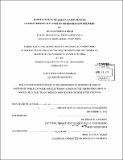Manufacturing of lab-on-a-chip devices : characterizing seals for on-board reagent delivery
Author(s)
Inamdar, Tejas Satish
DownloadFull printable version (23.64Mb)
Other Contributors
Massachusetts Institute of Technology. Department of Mechanical Engineering.
Advisor
Brian W. Anthony.
Terms of use
Metadata
Show full item recordAbstract
The reagent delivery mechanism in a point-of-care, HIV diagnostic, microfluidic device is studied. Reagents held in an aluminum pack are released on the opening of a fluidic seal. Fluidic seals, controlling the flow of reagents, are characterized to reduce anomalies in the desired flow pattern. The nature of the current seal was investigated. Four seal patterns - line hemisphere, line flat, chevron hemisphere and chevron flat were created and tested for reagent delivery using a flow sensor and a force gauge. Preliminary experiments suggested that one of the patterns - "line-flat" - resulted in fewer flow anomalies. A parameter scoping exercise involving sealing process parameters (temperature, time, gap and distance) was performed for the line flat seal. The findings of this research can be divided into three categories - 1) bonding phenomenon in current seals, 2) influence of seal pattern on flow and rupture mechanics and 3) process parameters which result in the least flow anomalies. The current seal is found to be a bond between the exposed aluminum on the lid film and the heat seal coating on the dome film. The two chevron patterns result in large amounts of flow anomalies, the line hemisphere pattern also resulted in some instances of flow anomalies. The line-flat pattern creates a seal with the least flow anomalies. A specific set of temperature, time, gap and distance which minimizes flow anomalies was found. The flow performance of the reservoir improved and delamination decreased as the distance of the seal from the reservoir was reduced. The thesis also develops a model to better understand the deformation of the reagent carrying dome and flow dynamics prior to and following the opening of the seal. The dome deformation model provides a framework for relating volume, delamination and flow rate to the geometry and material properties of the reservoir pack.
Description
Thesis (M. Eng. in Manufacturing)--Massachusetts Institute of Technology, Dept. of Mechanical Engineering, 2013. Cataloged from PDF version of thesis. Includes bibliographical references (p. 93-94).
Date issued
2013Department
Massachusetts Institute of Technology. Department of Mechanical EngineeringPublisher
Massachusetts Institute of Technology
Keywords
Mechanical Engineering.